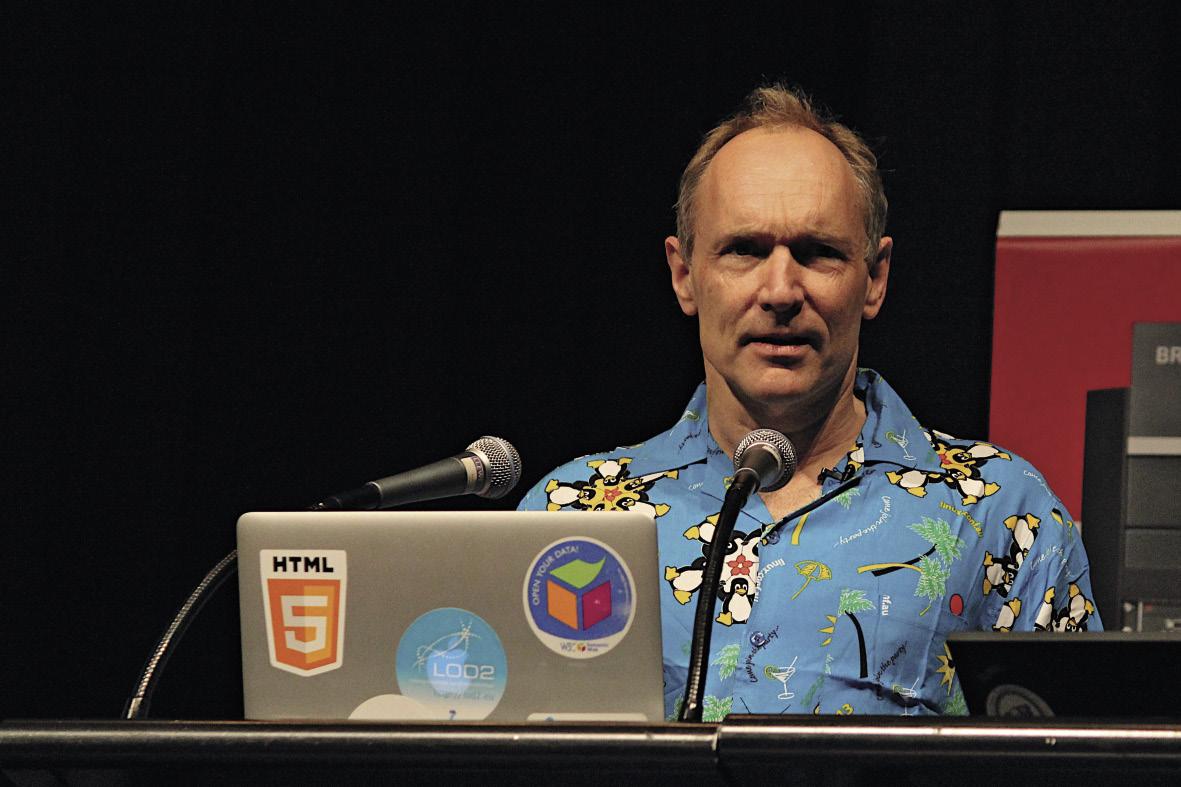Tim Berners-Lee, inventor and web monitor
2018/06/01 Leturia Azkarate, Igor - Informatikaria eta ikertzailea Iturria: Elhuyar aldizkaria

Sir Tim Berners-Lee was born in 1955 in London. After studying physics at Queen’s College in Oxford, for several years he worked as an engineer in several companies. In 1980 he worked for the Swiss CERN as an external contractor for a few months. He then proposed a hypertext-based system to share information among researchers and built a prototype called ENQUIRE. Hypertext is a digital text with references to other texts (hyperlinks). The web is based on hypertext and the ENQUIRE system is considered a precedent of the web. In 1984 he returned to CERN to work as a member of the organization and in 1989 he invented the web.
But what is the web?
At that time, the Internet already existed, although it was not so widespread. Internet is a network of interconnected computers that uses TCP/IP (Transmission Control Protocol / Internet Protocol) and DNS (Domain Name System) protocols to communicate with each other, on which services such as email, FTP, chat, etc. can circulate. CERN was then the largest internet node in Europe. Thus, it occurred to Berners-Lee to connect the idea of the hypertext he had worked years before with the Internet and published a report on it, on March 12, 1989. This means the creation of WWW (World Wide Web).
But Berners-Lee, beyond the idea, implemented it and launched it. This first report was not approved by those responsible, but the review made in 1990. He then defined the HTML format and the HTTP protocol (that is, the Hypertext Markup Language, the format used for the elaboration of web pages, and the Hypertext Transfer Protocol, protocol for the exchange of web pages and requests between a server and a web browser), which currently remain the basis of the web, developed and adapted. He also performed the first web browser (which he called WorldWideWeb and used to edit web pages) and the first web server (called CERN httpd). And finally, it launched the first webpage in http://info.cern.ch/hypertext/WWW/TheProject.html.
In addition to getting right, taking care of the evolution of the web
In the coming years the web experienced strong growth. Various software was developed for the web server, many browsers and web pages and users multiplied. Along with this, as always, business interests emerged that have since wanted to control several companies. With the output of a web browser and hegemony in the browser market, Microsoft tried to adapt the HTML format to its interests in the second half of the 1990s with Internet Explorer, and Google, now, with Chrome, tries to be the only advertising pie.
To avoid this and to keep the web as a world heritage site, in 1994 Berners-Lee created the World Wide Web Consortium (W3C), of which he is director. This organism defines the formats of the web (mentioned HTTP and HTML, and many others that have been created later, such as XML, DOM, CSS...). All these formats are published as agreed standard, free of patents and royalties. In addition, in 2008 he created the World Wide Web Foundation, with objectives quite similar to those of the W3C, but instead of dealing with technical issues, he does other work: expand the idea of free and open web, actions to make the web accessible to everyone, etc.
Current web risks
This last organization, the World Wide Web Foundation, was the one that Berners-Lee took advantage of last March 12 to spread the message of the 29th anniversary of the web. According to the message, this year, for the first time, more than half of the world's population will be online. And one of the needs you see is to connect as soon as possible the other half (in general, the inhabitants of poor countries, women, rural environments…) so that the digital divide does not expand and the other half of the population has the same opportunities to learn, earn money, be informed and enjoy the services of the web.
It also mentions another danger: that the web is increasingly in the hands of fewer dominant platforms. That is really happening. What was once a rich ecosystem of websites, blogs and media has now changed, and most people spend more time on websites of few companies. These websites have enormous power to channel people's opinions, voluntarily or involuntarily, through which the famous fake news is disseminated. And their domain greatly hinders the creation of new agents, because they buy competitors, they hire all the talent, they have a lot of information about users…
Also last year, on the same date, on the occasion of the 28th anniversary of the web, made new warnings. He then alerted us of the loss of control of our personal data. We are not even aware of the amount of information that large companies store about us in exchange for offering free services. They are data that take advantage, at best, so that we are satisfied but imprisoned on their platforms, and in the worst case, to sell to advertising agencies, to deliver them to governments...
Add to this the trend that is spreading to replace apps on mobile phones with web apps. These go over the Internet, but each uses its own programming languages and communication protocols instead of web standards.
It will not be easy to turn around these worrying trends that the web has taken. But the first step to starting to change something that is wrong is to realize that it is wrong. We cannot say that Tim Berners-Lee has not tried to realize it.

Gai honi buruzko eduki gehiago
Elhuyarrek garatutako teknologia





